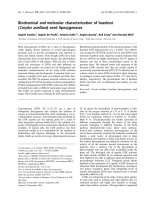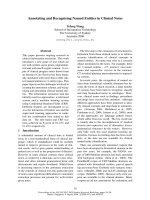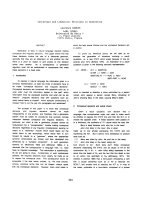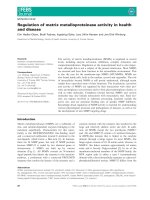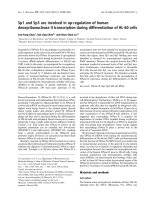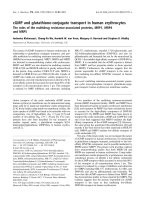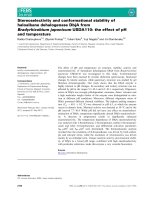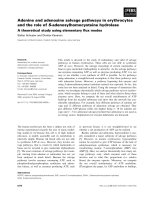báo cáo khoa học: " Copia and Gypsy retrotransposons activity in sunflower (Helianthus annuus L.)" pdf
Bạn đang xem bản rút gọn của tài liệu. Xem và tải ngay bản đầy đủ của tài liệu tại đây (535.65 KB, 12 trang )
BioMed Central
Page 1 of 12
(page number not for citation purposes)
BMC Plant Biology
Open Access
Research article
Copia and Gypsy retrotransposons activity in sunflower (Helianthus
annuus L.)
Marco Vukich, Tommaso Giordani, Lucia Natali and Andrea Cavallini*
Address: Dipartimento di Biologia delle Piante Agrarie, Università di Pisa, Via del Borghetto 80, I-56124 Pisa, Italy
Email: Marco Vukich - ; Tommaso Giordani - ; Lucia Natali - ;
Andrea Cavallini* -
* Corresponding author
Abstract
Background: Retrotransposons are heterogeneous sequences, widespread in eukaryotic
genomes, which refer to the so-called mobile DNA. They resemble retroviruses, both in their
structure and for their ability to transpose within the host genome, of which they make up a
considerable portion. Copia- and Gypsy-like retrotransposons are the two main classes of
retroelements shown to be ubiquitous in plant genomes. Ideally, the retrotransposons life cycle
results in the synthesis of a messenger RNA and then self-encoded proteins to process
retrotransposon mRNA in double stranded extra-chromosomal cDNA copies which may integrate
in new chromosomal locations.
Results: The RT-PCR and IRAP protocol were applied to detect the presence of Copia and Gypsy
retrotransposon transcripts and of new events of integration in unstressed plants of a sunflower
(Helianthus annuus L.) selfed line. Results show that in sunflower retrotransposons transcription
occurs in all analyzed organs (embryos, leaves, roots, and flowers). In one out of sixty-four
individuals analyzed, retrotransposons transcription resulted in the integration of a new element
into the genome.
Conclusion: These results indicate that the retrotransposon life cycle is firmly controlled at a post
transcriptional level. A possible silencing mechanism is discussed.
Background
The mobile component of the genome is represented by
sequences, called transposable elements (TEs), which are
potentially able to change their chromosomal location
(transposition) through different mechanisms. This fea-
ture has a cladistic significance and TEs are subdivided
into two main classes accordingly to their mechanism of
transposition, retrotransposons (REs, class I) and DNA
transposons (class II). Class I elements, which includes all
REs, can transpose through a replicative mechanism
which involves the transcription of an RNA intermediate
by the enzyme machinery of the host cell, and subsequent
retrotranscription to cDNA and integration into the host
genome by the enzymes encoded by the retrotransposon
RNA. Such a "copy and paste" mechanism has been
largely successful during the evolution of eukaryotes in
which class I elements represent the largest portion of
higher plant genomes. In the case of Oryza australiensis,
the amplification of retrotransposons doubled the
genome size [1].
Published: 23 December 2009
BMC Plant Biology 2009, 9:150 doi:10.1186/1471-2229-9-150
Received: 31 July 2009
Accepted: 23 December 2009
This article is available from: />© 2009 Vukich et al; licensee BioMed Central Ltd.
This is an Open Access article distributed under the terms of the Creative Commons Attribution License ( />),
which permits unrestricted use, distribution, and reproduction in any medium, provided the original work is properly cited.
BMC Plant Biology 2009, 9:150 />Page 2 of 12
(page number not for citation purposes)
Retrotransposons are divided into autonomous and non-
autonomous elements, according to the presence of ORFs
that encode RE enzymes. Non-autonomous elements do
not carry enough coding capacity to allow them to trans-
pose autonomously, nevertheless they are able to move
using enzymes encoded by other elements [2].
Basically, the genome of autonomous REs is organized in
two domains: the gag domain, which is committed
towards the production of virus like particles, and the pol
domain, whose encoded enzymes are used for processing
RE-mRNA and obtaining a double stranded DNA to be
integrated into the genome. The occurrence of long termi-
nal repeats (LTRs) flanking the retrotransposon genome
distinguishes REs into two main classes, namely LTR- and
non-LTR-retrotransposons. LTRs carry promoter elements,
polyadenilation signals and enhancers regulating the tran-
scription of retroelements.
Gypsy and Copia LTR retrotransposons are two ubiquitous
classes [3,4] of plant REs that differ in the order of genes
encoded by pol. Gypsy and Copia elements resemble retro-
viruses in their structure due to the presence of LTRs and
internal ORFs. LTR-retrotransposons lacking internal cod-
ing domains, such as TRIMs (Terminal-repeat Retrotrans-
posons In Miniature [5]) and LARDs (LArge
Retrotransposons Derivatives [6]) have also been
described. Formerly discovered in Solanum tuberosum and
Arabidopsis, TRIMs have been reported in monocots and
dicots while LARDs, which were shown to be transcribed,
have been reported in Triticeae [4,6].
Over the last two decades, some examples have correlated
the emerging of RE activity in the genome with a stress
mediated reaction: Tnt1 and Tto1 in Nicotiana and Tos17
in rice showed stress-induced (by tissue culture) transcrip-
tion and transposition [7-10], while these elements were
not transcribed in standard culture conditions.
Large genome sequencing of grass plants showed that REs
are responsible for extensive changes in genome structure
and, surprisingly, dramatic differences were reported even
among individuals belonging to the same species [11,12].
A remarkable example of retrotransposon dynamics as an
evolutionary adaptive mechanism within an ecological
system is offered by BARE1 elements in wild barley [13].
It has been proposed that REs restructuring action plays a
role in regulating gene expression [14,15]. It has been sug-
gested that allelic variation in non-genic (regulatory)
sequence may be involved in heterosis, i.e. the superior
performance of hybrids in respect of their parents [16]. In
this sense, the old epithet of "junk" for such repeated
sequences, which have affected genome structure and
function, is becoming obsolete.
Though the interplay between REs and host genome has
allowed genome expansion and the evolution of the gene
expression regulating network, the vast majority of REs
seem to be inactivated by a large spectrum of mutations.
Only few elements have been shown to transpose auton-
omously and data from EST libraries in grasses indicate
that most are poorly transcribed [17-19]. However, it is
conceivable that the activity of REs should be limited by
the host genome because of their potential mutagenic
action.
The control of TEs activity is related to RNA interference,
a process mediated by small RNAs which derive from a
number of different precursors, determining chromatin
specific methylation and condensation, and RNA degra-
dation [20]. In the fission yeast Schizosaccharomyces pombe,
a basal level of transcripts matching centromeric DNA
repeats is the substrate for the production of small RNAs
that maintain heterochromatin structure through histone
methylation [21]. A silencing pathway of REs and repeti-
tive sequences, driven by anti-sense small RNAs, is well
described in Drosophila [22] and in Arabidopsis [23].
In plants, retrotransposon dynamics have mainly been
investigated in grasses and other monocotyledons, and in
dicotyledons such as Arabidopsis, Gossypium species, Nico-
tiana, and Lotus japonicus. Recently, genome expansion
related to the amplification of REs has been shown to
occur in the evolution of three Helianthus hybrid species
adapted to extreme environments [24,25].
The cultivated sunflower (Helianthus annuus) has a
medium-large sized genome (3.30 pg DNA per haploid
genome [26]. The occurrence of Copia and Gypsy REs has
been reported a few years ago for the first time [27] and,
lately, the main portion of sunflower genome was shown
to be composed by REs [28]. The analysis of cpDNA sug-
gested that the Helianthus genus originated between 4.75
and 22.7 million years ago while the Helianthus extant lin-
eages appeared between 1.7 and 8.2 million years ago
[29].
With the aim to study RE activity in a relatively young and
medium-large genome sized species, we have analyzed
retrotransposons transcription and integration of new REs
in plants of cultivated sunflower.
Results
REs expression in the Helianthus annuus genome
Sunflower repeated sequences were previously isolated
from a Helianthus annuus partial genomic library by
hybridization with labeled genomic DNA [27]. Among
these, one Copia-like sequence (pHaS211 [EMBL acc.
number AJ009967
], hereafter called C211) and three
Gypsy-like sequences (pHaS13 [AJ532592
], pHaS22
BMC Plant Biology 2009, 9:150 />Page 3 of 12
(page number not for citation purposes)
[FM208278], and pHaS30 [FM208279], hereafter called
G13, G22, and G30, respectively) resulted as being
medium repeated, with a copy number per haploid
genome ranging from 4,000 to 16,000 (Cavallini, unpub-
lished). These sequences were studied with respect to their
RNA transcription.
Specific PCR primers were designed on conserved
domains matching the RNAseH and the Integrase gene of
Copia and Gypsy elements, respectively. RT-PCR experi-
ments were performed to assess the occurrence of RE tran-
scripts in different organs such as root, leaf, flower (at
three different stages) and embryo (at four different
stages), collected from HCM line plants. For each organ
and stage, amplified fragments of the expected length
were obtained (Fig. 1), indicating that the retroelement
families studied are actively transcribed in all the organs
analyzed. Additional PCR products were obtained, that
might have been originated by the transcription of retro-
transposon remnants and/or related elements.
Three amplified fragments for each RT-PCR product were
cloned and sequenced (EMBL acc. numbers FM208268
-
FM208277
). Sequences belonging to the Copia-like ele-
ment did not show sequence polymorphism (Table 1).
This may indicate that only one or a few Copia REs belong-
ing to C211 family are transcribed, so that polymorphism
cannot be detected by sequencing only three PCR prod-
ucts. All nine sequences belonging to Gypsy-like REs were
RT-PCR analysis of sunflower retrotransposonsFigure 1
RT-PCR analysis of sunflower retrotransposons. RT-PCR products of C211, G22, G30, and G13 REs from total RNAs of
embryos at 7, 14, 21, 28 days after pollination (DAP), flowers at three different development stages (3, 7, and 12 mm in length),
roots and leaves. For each sample, RT-PCR reactions were performed on retrotranscribed RNA (R) and on the corresponding
non-retrotranscribed RNA (C). Molecular weight marker (M, Gene Ruler DNA Ladder Mix, Fermentas) was also loaded.
BMC Plant Biology 2009, 9:150 />Page 4 of 12
(page number not for citation purposes)
different, indicating that different elements of all analyzed
Gypsy-like families are transcribed.
Eight out of the nine Gypsy sequences and the Copia ones
do not show stop codons. In spite of the low number of
sequences analyzed, this result indicates that many of the
expressed REs encode functional protein sequences.
Within the G13, G22, and G30 families, the ratio between
synonymous and non synonymous substitutions was
0.071, 0.086, and 0.189, respectively, i.e., close to zero
(Table 1). Such low ratios are usually found in coding
gene sequences and they indicate conservative selection. A
BLAST search on EST databases using sequences of three
Gypsy and one Copia REs as queries, indicated that RE fam-
ilies related to those analyzed in our experiments are tran-
scribed also in other Asteraceae species (Table 2) for
which EST data are available, both belonging to the Heli-
anthusgenus (H. argophyllus, H. ciliaris, H. exilis, H. para-
doxus, H. tuberosus) or to other genera (Artemisia annua,
Senecio cambrensis, S. chrisanthemifolius, S. vulgaris, Cartha-
mus tinctorius, Centaurea solstitialis, Cichorium intybus, Lac-
tuca perennis, L. sativa, L. serriola, Zinnia elegans).
Isolation and analysis of LTRs
Putative full-length Gypsy-like LTRs were isolated by two-
step chromosome walking, following the method
reported for sunflower Copia-like LTRs [30].
Twelve putative Gypsy LTRs (EMBL acc. numbers
FM177929
-FM177940) and 18 putative Copia LTR
(FM177911
- FM177928[30]) were aligned and a consen-
sus tree, based on nucleotide sequences, was obtained by
the neighbor-joining analysis (Fig. 2). The tree showed a
clear distinction between Gypsy and Copia LTRs. Moreover,
Copia LTRs resulted to be more uniform than Gypsy ones
(Table 3), for which three distinct families are observed
(Fig. 2). Calculation of nucleotide diversity along the rel-
atively uniform Copia LTRs indicated that diversity is
higher in the central region of LTR than at both ends (not
shown).
CLUSTAL alignment clearly showed conserved putative
TATA box promoter both in the Gypsy (TATAAA) and in
the Copia (TATATATA) LTRs. To analyze the structure of a
putative RE promoter, isolated Copia and Gypsy LTRs were
Table 1: Number of sites, nucleotide diversity per site (π) and per non-synonymous and synonymous sites, of coding portions of
different retrotransposon families of H. annuus.
Sequence N. of sequences N. of sites π N. of non-synonymous sites π
a
N. of synonymous sites π
s
π
a
/π
s
G13 3 710 0.0451 538.50 0.011 169.50 0.154 0.071
G22 3 740 0.1378 573.06 0.041 164.94 0.477 0.086
G30 3 467 0.0828 359.22 0.042 105.78 0.222 0.189
C211 3 252 0.0000 197.17 0.000 54.83 0.000
Table 2: Hits showing sequence similarity with G13, G30, G22, and C211 REs in EST libraries of different Asteraceae species.
Subfamily Tribe Species G13 G22 G30 C211
TSUTSU T S U TSU
Asteroidee Heliantheae Helianthus annuus 512 513 - - - 21 -
H. argophyllus 1 3 - - -
H. ciliaris 1
H. exilis 1 1 - - -
H. paradoxus 3 1 - - -
H. tuberosus 2 2 - - -
Zinnia elegans 22 - 55 - 1 1 - - - -
Anthemideae Arthemisia annua 1-11-120-20 -
Senecioneae Senecio cambrensis 1-11-1 - - - 1-1
S. chrysanthemifolius 1-1
S. vulgaris 1-11-1
Carduoideae Cardueae Carthamus tinctorius 1 1 - - -
Centaurea solstitialis 1-1 - - -
Cichorioideae Cichorieae Cichorium intybus 1-13-3
Lactuca perennis 1 - - -
L. sativa 22-2 - - -
L. serriola 1 - - -
T: total of EST matches, S: transcripts from stressed tissues, U: transcripts from unstressed tissues. Matches were considered reliable according to
their E-value (e
-5
) with variable minimum query coverage: 10% for G13 (710 bp-long) and for G22 (740 bp-long), 45% for G30 (467 bp-long) and for
C211 (252 bp-long).
BMC Plant Biology 2009, 9:150 />Page 5 of 12
(page number not for citation purposes)
Phylogenetic analysis of isolated LTRsFigure 2
Phylogenetic analysis of isolated LTRs. Neighbour-joining analysis of alignment of LTRs of H. annuus. Bar represents dis-
tance (percent divergence) between all pairs of sequence from the multiple alignments (CL: putative Copia LTR; GL: putative
Gypsy LTR).
BMC Plant Biology 2009, 9:150 />Page 6 of 12
(page number not for citation purposes)
scanned for cis-elements against the PLACE database [31].
In all the LTRs analyzed, stress-responsive cis-elements as
Myb, Myc, and WRKY motifs were found. Cis-elements
typical of constitutively expressed genes such as Dof-
related elements [32] and CACT boxes [33] were
observed. Also many putative light responsive elements,
such as GATA boxes and GT1 binding sites [34], tissue-
specific motifs such as SEF3 binding sites [35], were found
in all the LTRs analyzed. All these elements may account
for the observed RE expression. It is to be noted that sim-
ilar cis-elements can be observed in both strands of ana-
lyzed LTRs.
Insertion of new REs in the genome
To investigate whether Copia and Gypsy transcriptional
activity leads to the integration of daughter copies in the
genome of Helianthus annuus, the IRAP protocol [36] was
applied to detect polymorphisms within the HCM line.
This sunflower line was subject to eighteen self-pollina-
tion cycles, thus it is to be considered as homozygous as
indicated by the phenotype uniformity. Since the IRAP
protocol displays RE fingerprinting arising from the
amplification of neighbour LTRs, new integrated copies of
LTR-retroelements can produce polymorphic bands if
they insert themselves close enough to a second element,
to be amplified by Taq DNA polymerase.
To detect RE-related polymorphisms, primers were
designed on the 5'- and the 3'-LTRs ends of Copia and
Gypsy elements. Since RE insertions are mutagenic and the
development of plantlets might be aborted, new events of
RE integration were surveyed in sunflower embryos from
four inflorescences, one for each developmental stage.
Sixty-four embryos (7, 14, 21, or 28 days after pollina-
tion) were tested, using specific Copia- and Gypsy-LTR
primers, respectively. Only a combination of LTR specific
primers (FF C-LTR/C-LTR2), matching a Copia retroele-
ment, produced a clear polymorphic band in a 14 day old
embryo (Fig. 3). This band was recovered from the gel,
and then cloned and sequenced (EMBL acc. number
FM209477
). The sequence was found to be delimited by
the two primers; 3'-Copia LTR and 5'-Copia LTR ends were
present, excluding unspecific primer annealing. The
sequence between the two LTRs (665 bp long) was iso-
lated in other HCM plants using primers designed on the
inter-retrotransposon sequence and it showed 100% sim-
ilarity with the same locus related to the polymorphic
band. To assess whether Copia LTRs flanked this locus in
plants of the HCM line, PCRs were performed with prim-
ers pointing outward from the genomic locus (Fig. 4). Of
the two possible amplified fragments, only one was
obtained of the expected molecular weight, containing a
portion of 5'- LTR, indicating the occurrence of a Copia
element in that side of the locus. This suggests that a new
Copia retrotransposon had inserted itself in the embryo on
the other side of the locus.
Discussion
McClintock [37] addressed the presence and activity of
mobile elements within the host as a chance for the
genome to cope with challenges to which it is not pre-
pared to react. The genome restructuring action of mobile
elements should have made available further genetic vari-
ability, increasing the possibility to overcome the chal-
lenge.
In the present work, RT-PCR experiments have demon-
strated that the Copia and the Gypsy REs families investi-
gated are transcribed in all Helianthus annuus analyzed
tissues, i.e. roots, leaves and flowers. Transcripts showed a
very low level of non synonymous/synonymous substitu-
tion rates. Similar ratios were reported for Copia, Gypsy,
and LINE REs also in other Asteraceae, as Hieracium auran-
tiacum, Taraxacum officinale and Antennaria parlinii, sug-
gesting a conservative selection [38]. Nine out of ten RE-
mRNA transcripts did not show any supernumerary stop
codon, supporting the presence of a potentially functional
segment of RE pol-proteins. That "parasite" sequences
with no apparent function for the host genome tend to
maintain their amino acid sequence may be somewhat
unexpected. A possible explanation is that only recently
inserted elements (i.e., those which have not been subject
to mutations yet) are functional.
BLAST screening against EST databases has shown that
transcripts related to these REs families are largely tran-
scribed in different Helianthus species and in other Aster-
aceae. Interestingly, G13 and G22 matches are distributed
Table 3: Number of sites, number of sites excluding gaps, nucleotide diversity (π) and its sampling variance for Gypsy and Copia LTR
sequences of H. annuus.
Sequence N. of sequences N. of sites N. of sites excluding gaps π variance of π
Gypsy LTRs 12 615 536 0.3842 0.0024
Copia LTRs
1
18 454 353 0.1325 0.0002
1
Data from Vukich et al. [30]
BMC Plant Biology 2009, 9:150 />Page 7 of 12
(page number not for citation purposes)
in several species belonging to different genera. It should
be noted that, in other dicots, retrotransposon ESTs were
reported to find matches only in their host species [18].
The isolation and sequencing of a number of full length
Copia and Gypsy 5'-LTRs showed the occurrence of a
proper TATA box and putative cis-elements in their
sequence. Transcripts were isolated using a poly-T primer
targeting the 3'-poli-A tail, showing that the 3'-ends of RE
transcripts were processed by the host genome. The occur-
rence of promoter sequences, of functional protein
sequences, the RE transcription and the RE-mRNA 3'-end
processing are all hints of autonomous retrotransposons.
It is known that REs are subject to inactivation by either
mutations or chromatin condensation. Replication allows
these elements to survive as genome parasites, but the
higher the replication rate the lower will be the host fit-
ness and, consequently, survival of the REs. In the sun-
flower, although the expression of REs is widespread in all
the tissues analyzed, IRAP experiments revealed only one
convincing polymorphism, which was attributable to a
new integration event. This suggests that, despite a sub-
stantial transcriptional activity, RE-mRNAs are quelled
and the insertion of new REs is inhibited at a post-tran-
scriptional level, as shown in other species including
humans (see [20]).
The amplification of REs in the genome can have some
functions for the host. For example, the occurrence in the
LTR of putative promoter elements such as those observed
in the sunflower could be used by the host to regulate the
expression of nearby genes. Constitutively active LTR pro-
moters could determine a housekeeping expression, while
tissue-specific LTR promoters would drive the expression
of genes in those tissues. An example of gene transcription
related to the activity of adjacent retrotransposons was
reported in wheat [39]. In mouse oocytes, retrotranspo-
IRAP analysis of sunflower embryosFigure 3
IRAP analysis of sunflower embryos. IRAP analysis in 20 sunflower embryos collected in the same flower-head of the
highly inbred line HCM. Molecular weight marker (M, Gene Ruler DNA Ladder Mix, Fermentas) was loaded on the left.
Embryo # 15 shows a clear polymorphic band.
BMC Plant Biology 2009, 9:150 />Page 8 of 12
(page number not for citation purposes)
son related transcripts are predominant in the mRNA pool
and LTR promoters are responsible for the transcription of
a set of genes [40].
The ubiquity of RE transcripts observed in sunflower tis-
sues, and the fact that REs are actively transcribed in stand-
ard culture conditions, can support the idea that
retrotransposons can be integrated into cell metabolism.
For instance, a basal level of retrotransposons transcrip-
tion would make available the "rough material", namely
dsRNAs, that can trigger RE silencing via RNA-directed
DNA methylation and chromatin remodeling [41] or via
a post-transcriptional mechanism [23]. Double stranded
RNA precursors may originate from transcribed nested,
head-to-tail oriented LTRs [39], from read-through tran-
scription of two elements which are head-to-tail oriented
or from anti-sense strand transcription [42-44].
In this sense, low-copy elements would be the most haz-
ardous for the host, because of the rareness of head-to-tail
orientation in the genome, so reducing the efficiency of
silencing mechanisms. Accordingly, the few elements in
plants for which new insertion events were shown, are
three Copia-like elements, Tnt1, Tto1, and Tos17, present in
a relatively low copy number (< 1,000) per haploid
genome (see [45]).
Previous analyses of sunflower REs revealed that they are
highly methylated [28]. The families of REs investigated in
this study are present in several thousands of copies
within the genome and are possibly methylated. How-
ever, the widespread transcription of such elements sug-
gests that RE silencing in this species occurs also by
degradation of RE mRNAs.
Conclusion
Retrotransposon transcription was shown in all sunflower
tissues analyzed in our experiments. RE activity is not
apparently induced by environmental factors or by culture
conditions. In one over 64 surveyed embryos a new RE
insertion occurred, possibly determining a mutation.
We can speculate that in the sunflower the rarity of inser-
tion events, observed in our experiments despite the con-
sistent transcriptional activity of the Copia and Gypsy RE
families investigated, would be linked to post-transcrip-
tional regulation of REs activity, probably through the
degradation of target RE mRNAs.
Methods
Plant materials, DNA and RNA extraction
Roots, leaves, embryos, and flowers were collected from
plants of the HCM line of Helianthus annuus, grown in the
field. The HCM line was developed at the Dept. of Crop
Plant Biology of University of Pisa after 18 self-pollina-
tion cycles, starting from an open-pollinated cultivar, and
it is a highly homozygous line, as indicated by phenotype
uniformity. Self-pollination was obtained by covering
inflorescences to prevent outcrossing. After sampling, tis-
sues were ground in liquid nitrogen. DNA was extracted
Schematic representation of polymorphism analysisFigure 4
Schematic representation of polymorphism analysis. A polymorphic band was detected in the HCM embryo # 15 (see
Fig. 4). Forward and reverse primers designed within the inter-retrotransposon locus and directed outward (blue arrows)
were coupled with specific LTR primers (black arrows). Only one fragment was amplified from plants of HCM line.
BMC Plant Biology 2009, 9:150 />Page 9 of 12
(page number not for citation purposes)
from embryos and leaves using a CTAB protocol [46] with
minor modifications. For total RNA extraction, a MES-
guanidine hydrochloride-containing buffer was used fol-
lowing the protocol described by Logeman et al. [47].
RNA purification
A tuned RNA purification protocol was tailored to avoid
genomic DNA contamination, i.e., DNA remnants invali-
dating RT-PCR analyses. Such a high level of accuracy is
crucial especially when analyzing RE expression because
of the high frequency of REs in the genomes.
RNA was purified by treatment with DNAse I (Roche). The
total amount of DNAse units was set according to the
maximum amount of glycerol allowed in the reaction
mixture, i.e. 25 μg total RNA, 10 × DNAse I incubation
buffer 5 μl, RNAse-free recombinant DNAse I 100 units
(10 μl total volume, 5 μl glycerol volume), DEPC water up
to 50 μl. Samples were incubated for 1 h at 37°C. After
DNAse treatment, RNA purification required a phenol-
chloroform extraction and standard precipitation with 1/
10 volume 3 M sodium acetate and 2 volumes of cold,
100% ethanol. Using this protocol any possible genomic
DNA contamination was prevented [see Additional file 1].
Expression analyses by RT-PCR
For retrotranscription, total RNA (5 μg) was heated for 3
min at 70°C and retrotranscribed in a 20 μl volume reac-
tion using 400 μM of each deoxynucleotide triphosphate,
0.25 μM poly(T) primer, 1×RT-Buffer, 1 mM DTT, 200 U
SuperScript III Reverse Transcriptase (Life Technologies).
The same quantity of RNA was processed as above but in
the absence of the reverse transcriptase and used as a neg-
ative control in RT-PCR.
PCRs were performed using 1/20 volume (1 μl) of retro-
transcribed cDNA, 2.5 mM MgCl
2
, 250 μM of each deox-
ynucleotide triphosphate, 1 μM of each retroelement-
specific oligonucleotides (Table 4), 1 U Taq DNA
polymerase (Biodyne), 20 μl volume reaction. Thermocy-
cling (30 cycles) was performed at 94°C for 30 s, 60°C for
30 s and 72°C for 80 s for G13 RE; at 94°C for 30 s, 55°C
for 30 s and 72°C for 80 s for G22 RE; at 94°C for 30 s,
53°C for 30 s and 72°C for 80 s for G30 RE; and at 94°C
for 30 s, 57°C for 30 s and 72°C for 30 s for C211 RE. PCR
products were visualized on 2% agarose gel and EtBr-
stained. Three products for each RE, amplified using RNA
isolated from embryos at 28 days after pollination, were
cloned in pGEM T-easy vector using manufacturer's
instructions, and sequenced.
Sequence analysis
Sequences were aligned using CLUSTAL W [48]. Some
adjustments were made by eye. Statistics of sequence pol-
ymorphisms were performed using the DnaSP program
version 3.51 [49]. Nucleotide diversity (π, i.e. the average
number of nucleotide differences per site) and its sam-
pling variance were calculated according to Nei [50],
equations 8.4 and 8.12, replacing 2n by n.
Relationships among LTR sequences were investigated by
the neighbour-joining (NJ) method (distance algorithm
after Kimura), using the PHYLIP program package Version
3.572 [51]: after sequence alignment, 500 versions of the
Table 4: Retrotransposon specific primers used in RT-PCR
reactions.
RT-PCR primers (Copia and Gypsy)
G13F 5'-TCAGACGGATGGGCAGTCTGAGCGA-3'
G13R 5'-ACTCTGGGCCACGACGGGAGTTCCA-3'
G22F 5'-ACGCGTTTGAACTTCAGTACGGCT-3'
G22R 5'-TCAGGACCTCTACGAGCATCC-3'
G30F 5'-GGTCTATCACCGGGTCTCAAC-3'
G30R 5'-TACCCGGAAATAATCGAAGTCGTG-3'
C211F 5'-GCTGGATGTCAGTTCTTAGG-3'
C211R 5'-GATTTCGATGTGTTTGGTCTT-3'
LTR isolation primers (Copia, Gypsy, and universal)
Copia ChWP3 5'-CGAGATGAGTGCGATGGGTGAAAT-3'
Gypsy ChWP4 5'-GCAGAGGTGGGAGATAGTCAGAT-3'
Anch. p 5'-ACCATCGTCCTCAGGTTAGTCAGG-3'
PBS
met
5'-TAGGTCGGAACAGGCTCTGATACCA-3'
P1FCo 5'-CTGGTGTCTGTAACTTGTCTGTATTCG-3'
P2FCo 5'-AAAGATATGCTTCGATTGATAGACCTC3'
P1FGy 5'-GTGAGTACGTACCAAATTTCGGGAC-3'
P2FGy 5'-TTTCAACTTGGGGATAATGTGACAAC -3'
IRAP primers (Copia)
FA C-LTR i-r 5'-AGAGCATTCTGTCCGAAACAC-3'
FC C-LTR-h 5'-TAGCTTGGATTCCGCACTCG-3'
FF C-LTR 5'-GGTTTAGGTTCGTAATCCTCCGCG-3'
C-LTR r-rt1 5'-CGATAGATGGTCCGAAGGATC-3'
C-LTR 1 5'-AGACACCAGTGGCACCAACA-3'
C-LTR 2 5'-ACAGACACCAGTGGCACCAAC-3'
IRAP primers (Gypsy)
1F G-LTR BO37 5'-GGACAATATCATGGTGCGGTTAC-3'
1F G-LTR DO48 5'-ACCCTTCTTGACGAGACCAGT-3'
G-LTR 1 5'-CTGGTTTTCCTGGGGTGTCA-3'
G-LTR 2 5'-GGGTTGTCACATTATCCCCAAG-3'
Polymorphic band analysis primers (Copia)
FF C-LTR 5'-GGTTTAGGTTCGTAATCCTCCGCG-3'
C-LTR 2 5'-ACAGACACCAGTGGCACCAAC-3'
EMB 1F 5'-TCTTGACATGGGTTGTGGGCT-3'
EMB 1R 5'-TCACATGAACACGGCTCACACA-3'
EMB 2F 5'-AGTCTAATGGGTCAGCATGG-3'
EMB 2R 5'-TCCCTGGTATGAGCCGAAGCTCT-3'
BMC Plant Biology 2009, 9:150 />Page 10 of 12
(page number not for citation purposes)
original alignment were generated using the SEQBOOT
program; then trees were generated using PROTDIST (or
DNADIST) and NEIGHBOR programs, using default
options. A strict consensus tree was obtained from the
available trees using the CONSENSE program.
Isolation of Gypsy LTRs
To isolate full length Gypsy LTRs a two-step PCR protocol
was applied [30]. Firstly, putative partial 3' LTR chromo-
some walking was performed: specific retrotransposon
forward primers designed onto a conserved domain
belonging to a Gypsy Integrase gene (GenBank Acc. Nr.
AJ532592
) (Gypsy ChWp4, Table 4) were coupled with a
random annealing reverse primer (5'-ACCATCGTCCT-
CAGGTTAGTCAGG-3', Ra A-P). PCR products were
amplified using 30 ng DNA, 2.5 mM MgCl
2
, 0.5 μM prim-
ers, 1 U Taq FirePol (Biodyne) DNA polymerase, 20 μl
volume reaction. Thermocycling was performed at 94°C
for 30 s, 60°C for 30 s and 72°C for 2 min, for 30 cycles.
Products longer than 1,000 bp were cloned and
sequenced as above. Clustal analyses were performed to
address putative polypurine tract (PPT) whose location is
usually a couple of nucleotides before the 3' LTR begin-
ning. Due to the remarkable LTR sequence variability and
the lack of large conserved sequence traits, at this stage the
3' boundaries of the 3' LTR within the sequenced clones
could not be determined.
In the second step, isolation of complete 5' LTRs was per-
formed. As the retrotransposon LTRs were made identical
before the retroelement genome integration, primers
designed in the 3'LTR would be expected to match both
LTRs. Therefore, specific forward primers were designed
downstream of the putative PPT matching Gypsy-like 3'
LTR, (P1FGypsy and P2FGypsy respectively at bases 51-75
and bases 84-109 after the canonical 5 ' TG) and coupled
with a universal primer designed onto the primer binding
site (PBS) related to the tRNA
met
sequence pointing
towards the 5' LTR (PBS
met
, 5'-TAGGTCGGAACAG-
GCTCTGATACCA-3' [52]). Thermocycling was performed
at 94°C for 30 s, 57°C for 30 s and 72°C for 60 s, for 30
cycles. PCR products resulting from a semi- nested PCR
between P2FGypsy- and PBS-primer were visualized on
EtBr-stained agarose gel, cloned as above and sequenced.
IRAP protocol
Ten primers were designed on Copia and Gypsy LTR ends
(Table 4). Embryos DNAs were amplified using 20 ng
DNA, 2.5 mM MgCl
2
, 0.25 μM primers, 1 U Taq FirePol
(Biodyne) DNA polymerase, 20 μl volume reaction. Ther-
mocycling was performed at 94°C for 30 s, 55°C for 30 s,
and 72°C for 150 s. PCR products were visualized on 2%
EtBr-stained agarose gel.
Polymorphic band analysis
A polymorphic fragment was recovered from the gel,
cloned in pGEM T-easy vector using the manufacturer's
instructions, and sequenced. Specific primers (EMB 1F,
EMB 1R, Table 4) were designed to amplify the same
genomic locus in individuals of the same HCM line by
PCR, using 30 ng DNA, 2.5 mM MgCl
2
, 0.5 μM primers
final concentration, 1 U Taq FirePol (Biodyne) DNA
polymerase, 20 μl volume reaction. Thermocycling was
performed at 94°C for 30 s, 60°C for 30 s, 72°C for 2
min. Primers (EMB 2F, EMB 2R, Table 4) were designed
on the polymorphic isolated locus. The LTR primers (FF
C-LTR, C-LTR2, Table 4) were coupled with EMB 2F and
EMB 2R, and PCR was performed using the same reaction
mixture as above, at 94°C for 30 s, 57°C for 30 s, 72°C
for 1 min. PCR products were cloned as above and
sequenced.
Abbreviations
RE: retrotransposon; TE: transposable element; ORF: open
reading frame; LTR: long terminal repeat; IRAP: inter ret-
rotransposon amplified polymorphism.
Authors' contributions
MV, TG, LN and AC conceived and designed the study. MV
performed sequence isolation and identification, expres-
sion and phylogenetic analyses, IRAP polymorphism
detection. TG contributed to generate the data. MV and
AC wrote the manuscript. LN and TG participated in the
interpretation and discussion of results and contributed to
the writing of the paper. AC is the principal investigator
for the Helianthus projects and coordinated the study. All
authors read and approved the final manuscript.
Additional material
Acknowledgements
This work was supported by PRIN-MIUR, Projects "Caratterizzazione della
componente ripetitiva di genomi complessi in specie vegetali: modelli per
angiosperme e gimnosperme" and "Variabilità di sequenza ed eterosi in
piante coltivate".
References
1. Piegu B, Guyot R, Picault N, Roulin A, Samiyal A, Kim H, Collura K,
Brar DS, Jackson S, Wing RA, Panaud O: Doubling genome size
without polyploidization: dynamics of retrotransposition
Additional file 1
Checking DNA contamination in RT-PCR analysesThe file describes the
experimental procedures performed to exclude that the results of expression
analyses by RT-PCR are altered by possible genomic DNA contamination
of cDNA.
Click here for file
[ />2229-9-150-S1.PDF]
BMC Plant Biology 2009, 9:150 />Page 11 of 12
(page number not for citation purposes)
driven genomic expansion in Oryza australiensis, a wild rela-
tive of rice. Genome Research 2006, 16:1262-1269.
2. Tanskanen JA, Sabot F, Vicient C, Schulman AH: Life without GAG:
The BARE-2 retrotransposon as a parasite's parasite. Gene
2007, 390:166-174.
3. Voytas DF, Cummings MO, Konieczny A, Ausubel FM, Rodermel SR:
Copia-like retrotransposons are ubiquitous among plants.
Proc Natl Acad Sci USA 1992, 89:7124-7128.
4. Suoniemi A, Tanskanen J, Schulman AH: Gypsy-like retrotrans-
posons are widespread in the plant kingdom. Plant Journal
1998, 13:699-705.
5. Witte CP, Le QH, Bureau T, Kumar A: Terminal-repeat retro-
transposons in miniature (TRIM) are involved in restructur-
ing plant genomes. Proc Natl Acad Sci USA 2001, 98:13778-13713.
6. Kalendar R, Vicient CM, Peleg O, Anamthawat-Jonsson K, Bolshoy A,
Schulman AH: Large retrotransposon derivatives: abundant,
conserved but non autonomous retroelements of barley and
related genomes. Genetics 2004, 166:1437-1450.
7. Hirochika H: Activation of tobacco retrotransposons during
tissue culture. EMBO Journal 1993, 12:2521-2528.
8. Hirochika H, Sugimoto K, Otsuki Y, Tsugawa H, Kanda M: Retro-
transposons of rice involved in mutations induced by tissue
culture. Proc Natl Acad Sci USA 1996, 93:7783-7788.
9. Grandbastien MA: Activation of plant retrotransposons under
stress conditions. Trends Plant Science 1998, 3:181-189.
10. Grandbastien MA, Audeon C, Bonnivard E, Casacuberta JM, Chal-
houb B, Costa APP, Le QH, Melayah D, Petit M, Poncet C, Tam SM,
Van Sluys MA, Mhiri C: Stress activation and genomic impact of
Tnt1 retrotransposons in Solanaceae. Cytogenet Genome Res
2005, 110:229-241.
11. Brunner S, Fengler K, Morgante M, Tingey S, Rafalski A: Evolution of
DNA sequence nonhomologies among maize inbreds. Plant
Cell 2005, 17:343-360.
12. Scherrer B, Isidore E, Klein P, Kim JS, Bellec A, Chalhoub B, Keller B,
Feuillet : Large intraspecific haplotype variability at the Rph7
locus results from rapid and recent divergence in the barley
genome. Plant Cell 2005, 17:361-374.
13. Kalendar R, Tanskanen J, Immonen S, Nevo E, Schulman AH:
Genome evolution of wild barley (Hordeum spontaneum) by
BARE-1 retrotransposons dynamic in response to sharp
microclimatic divergence. Proc Natl Acad Sci USA 2000,
12:6603-6607.
14. Kobayashi S, Goto-Yamamoto N, Hirochika H: Retrotransposon-
induced mutations in grape skin color. Science 2004, 304:982.
15. Clark RM, Wagler TN, Quijada P, Doebley J: A distant upstream
enhancer at the maize domestication gene tb1 has pleio-
tropic effects on plant and inflorescence architecture. Nat
Genet 2006, 38:594-597.
16. Morgante M, De Paoli E, Radovic S: Transposable elements and
the plant pan-genomes. Curr Opin Plant Biology 2007, 10:149-155.
17. Meyers BC, Tingey SV, Morgante M: Abundance, distribution,
and transcriptional activity of repetitive elements in the
maize genome. Genome Research 2001, 11:1660-1676.
18. Vicient CM, Jaaskelainen M, Kalendar R, Schulman AH: Active ret-
rotransposon are a common feature of grass genomes. Plant
Physiology 2001, 125:1283-1292.
19. Vicient CM, Schulman AH: Copia-like retrotransposons in rice
genome: few and assorted. Genome Letters 2002, 1:35-47.
20. Slotkin RK, Martienssen R: Transposable elements and the epi-
genetic regulation of the genome. Nat Rev Genet 2007,
8:272-285.
21. Volpe A, Kidner C, Hall IM, Teng G, Grewal SIS, Martienssen RA:
Regulation of heterochromatic silencing and histone H3
Lysine-9 methylation by RNAi. Science 2002, 297:1833-1837.
22. Vagin VV, Sigova A, Li C, Seitz H, Gvozdev V, Zamore PD: A distinct
small RNA pathway silences selfish genetic elements in the
germline. Science 2006, 313:320-324.
23. Lisch D: Epigenetic regulation of transposable elements in
plants. Annu Rev Plant Biol 2009, 60:43-66.
24. Ungerer MC, Strakosh SC, Zhen S, Zhen Y: Genome expansion in
three hybrid sunflower species is associated with retrotrans-
poson proliferation. Current Biology 2006, 16:872-873.
25. Ungerer MC, Strakosh SC, Stimpson KM: Proliferation of Ty3/
Gypsy-like retrotransposons in hybrid sunflower taxa
inferred from phylogenetic data. BMC Biology 2009, 7(40):.
doi:10.1186/1741-7007-7-40
26. Cavallini A, Zolfino C, Natali L, Cionini G, Cionini PG: Nuclear
DNA changes within Helianthus annuus L.: origin and control
mechanism. Theor Appl Genet 1986, 73:20-26.
27. Santini S, Cavallini A, Natali L, Minelli S, Maggini F, Cionini PG: Ty1/
Copia- and Ty3/Gypsy-like DNA sequences in Helianthus spe-
cies. Chromosoma 2002, 111:192-200.
28. Cavallini A, Natali L, Zuccolo A, Giordani T, Jurman I, Ferrillo V, Vita-
colonna N, Sarri V, Cattonaro F, Ceccarelli M, Cionini PG, Morgante
M: Analysis of transposons and repeat composition of the
sunflower (Helianthus annuus L.) genome. Theor Appl Genet
2009. doi 10.1007/s00122-009-1170-7
29. Schilling EE: Phylogenetic analysis of Helianthus (Asteraceae)
based on chloroplast DNA restriction site data. Theor Appl
Genet 1997, 94:925-933.
30. Vukich M, Schulman AH, Giordani T, Natali L, Kalendar R, Cavallini A:
Genetic variability in sunflower (Helianthus annuus L.) and in
the Helianthus genus as assessed by retrotransposon-based
molecular markers. Theor Appl Genet 2009. DOI: 10.1007/s00122-
009-1106-2
31. Higo K, Ugawa Y, Iwamoto M, Korenaga T: Plant cis-acting regu-
latory DNA elements (PLACE) database: 1999. Nucleic Acids
Res 1999, 27:297-300.
32. Yanagisawa S, Schmidt RJ: Diversity and similarity among recog-
nition sequences of Dof transcription factors. Plant J 1999,
17:209-214.
33. Gowik U, Burscheidt J, Akyildiz M, Schlue U, Koczor M, Streubel M,
Westhoff P: Cis-Regulatory elements for mesophyll-specific
gene expression in the C4 plant Flaveria trinervia, the pro-
moter of the C4 phosphoenolpyruvate carboxylase gene.
Plant Cell 2004, 16:1077-1090.
34. Terzaghi WB, Cashmore AR: Light-regulated transcription.
Annu Rev Plant Physiol Plant Mol Biol 1995, 46:445-474.
35. Allen RD, Bernier F, Lessard PA, Beachy RN: Nuclear factors
interact with a soybean beta-conglycinin enhancer. Plant Cell
1989, 1:623-631.
36. Kalendar R, Schulman AH: IRAP and REMAP for retrotranspo-
son-based genotyping and fingerprinting. Nature Protocols 2006,
1:2478-2484.
37. McClintock B: The significance of responses of the genome to
challenge. Science 1984, 226:792-801.
38. Docking TR, Saadé FE, Elliot MC, Shoen DJ: Retrotransposon
sequence variation in four asexual plant species. J Mol Evol
2006, 62:375-387.
39. Kashkush K, Feldman M, Levy AA: Transcriptional activation of
retrotransposons alters the expression of adjacent genes in
wheat. Nature Genetics 2003, 33:102-106.
40. Peaston AE, Evsikov AV, Graber JH, De Vries WN, Holbrook AE, Sol-
ter D, Knowles BB: Retrotransposons regulate host genes in
mouse oocytes and preimplantation embryos. Dev Cell 2004,
7:597-606.
41. Huettel B, Kanno T, Daxinger L, Bucher E, Winden J Van Der, Matzke
AJM, Matzke M: RNA-directed DNA methylation mediated by
DRD1 and PolIVb: a versatile pathway for transcriptional
gene silencing in plants. Biochim Biophys Acta 2007, 1769:358-374.
42. Copeland SC, Mann VH, Brindley PJ: Both sense and antisense
strands of the LTR of the Schistosoma mansoni Pao-like retro-
transposon Sinbad drive luciferase expression. Mol Genet
Genomics 2007, 277:161-170.
43. Belo A, Nobuta K, Venu RC, Janardhanan PE, Wang GL, Meyers BC:
Transposable element regulation in rice and Arabidopsis:
diverse patterns of active expression and siRNA-mediated
silencing. Tropical Plant Biol 2008, 1:72-84.
44. Shpiz S, Kwon D, Rozovsky Y, Kalmykova : rasiRNA pathway con-
trols antisense expression of Drosophila telomeric retro-
transposons in the nucleus. Nucl Acids Res 2009, 37:268-278.
45. Yamazaki M, Tsugawa H, Miyao A, Yano M, Wu J, Yamamoto S, Mat-
sumoto T, Sasaki T, Hirochika H: The rice retrotransposon Tos17
prefers low-copy-number sequences as integration targets.
Mol Genet Genomics 2001, 265:336-344.
46. Doyle JJ, Doyle JL: Isolation of plant DNA from fresh tissue.
Focus 1989, 12:13-15.
47. Logemann J, Schell J, Willmitzer L: Improved method for the iso-
lation of RNA from plant-tissue. Analytical Biochemistry 1987,
163:16-20.
48. Thompson JD, Desmond G, Gibson H, Gibson TJ: CLUSTAL W
improving the sensitivity of progressive multiple sequence
Publish with BioMed Central and every
scientist can read your work free of charge
"BioMed Central will be the most significant development for
disseminating the results of biomedical research in our lifetime."
Sir Paul Nurse, Cancer Research UK
Your research papers will be:
available free of charge to the entire biomedical community
peer reviewed and published immediately upon acceptance
cited in PubMed and archived on PubMed Central
yours — you keep the copyright
Submit your manuscript here:
/>BioMedcentral
BMC Plant Biology 2009, 9:150 />Page 12 of 12
(page number not for citation purposes)
alignment through sequence weighting, position-specific gap
penalties and weight matrix choice. Nucleic Acids Res 1994,
22:4673-4680.
49. Rozas J, Rozas R: DnaSP version 3: an integrated program for
molecular population genetics and molecular evolution anal-
ysis. Bioinformatics 1999, 15:174-175.
50. Nei M: Molecular Evolutionary Genetics. Columbia University
Press, New York, NY; 1987.
51. Felsenstein J: PHYLIP: phylogeny inference package. Cladistics
1989, 5:164-166.
52. Kalendar R, Tanskanen J, Chang W, Antonius K, Sela H, Peleg O,
Schulman AH: Cassandra retrotransposons carry independ-
ently transcribed 5S RNA. Proc Natl Acad Sci USA 2008,
105:5833-5838.
